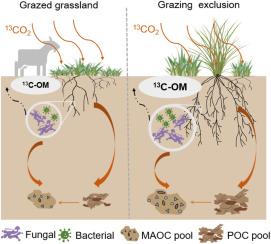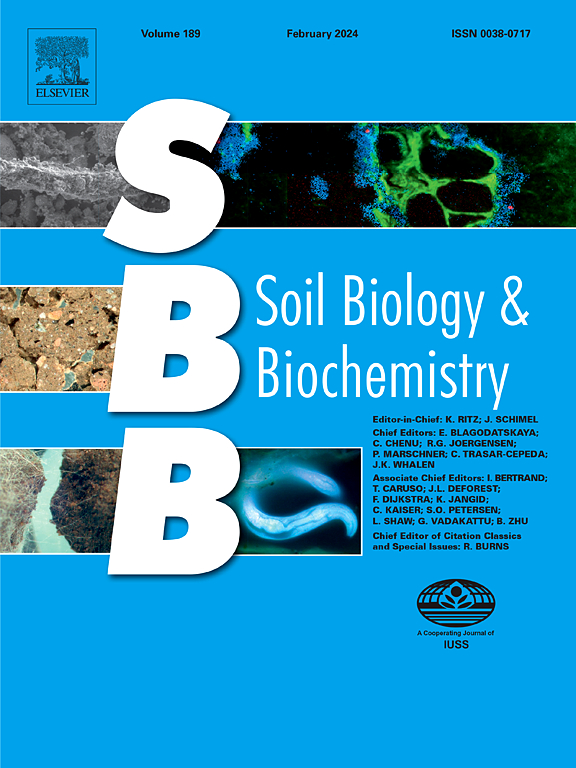Grazing exclusion enhanced the capability of soil microorganisms to access photosynthetic carbon in Loess Plateau grassland
IF 9.8
1区 农林科学
Q1 SOIL SCIENCE
引用次数: 0
Abstract
Photosynthetic carbon (C) has a pivotal role in the C cycle of the plant-soil system, contributing significantly to soil organic C (SOC) accrual. Grassland soils have a large capacity to store organic C and grazing is an important factor influencing the C cycle, but few studies have quantitatively how grazing exclusion affects the transfer of photosynthetic C in a plant-soil-microbial system. We used in situ isotope pulse-chase methodology to study photosynthetic C allocation patterns in the grazed and grazing-excluded grassland soil of the Loess Plateau, China. Grazing exclusion increased the total assimilated 13C by 46% compared with the grazed grassland, but did not significantly change the 13C allocated to the aboveground (75%) and belowground (25%) plant biomass. The 13C transferred faster to soil via root exudates in the grazed soil with lower aboveground biomass, suggesting that removal of aboveground biomass by grazing animals influences the rate of C transfer. Most (79%) the SOC gained from grazing exclusion accumulated in the mineral associated organic C (MAOC) pool, which is a stronger predictor of SOC accrual than particulate organic C (POC). Grazing exclusion increased the transformation of POC to MAOC, mainly through the accumulation of microbial necromass. Grazing exclusion significantly reduced the G+/G- ratio and the fungal/bacteria ratio, indicating a shift in soil microbial community composition in favor of bacteria over fungi under grazing exclusion. Grazing exclusion increased the microbial biomass by 48% and significantly enhanced the capability of soil fungi and G- bacteria to access photosynthetic C. In summary, grazing exclusion increases the magnitude of C transfer from the atmosphere to soil microbial biomass, and the gradual conversion of POC to MAOC.


禁牧提高了黄土高原草地土壤微生物获取光合碳的能力
光合碳(C)在植物-土壤系统的碳循环中起着关键作用,也是土壤有机碳(SOC)积累的重要贡献者。草地土壤具有较大的有机碳储存能力,放牧是影响有机碳循环的重要因素,但很少有研究定量评估放牧对植物-土壤-微生物系统光合碳命运的影响。采用原位同位素脉冲追踪方法研究了黄土高原放牧和非放牧草地土壤光合碳的分配规律。与放牧相比,不放牧使13C总同化量增加了46%,但对地上(75%)和地下(25%)的13C分配没有显著影响。在地上生物量较低的放牧土壤中,13C通过根系分泌物向土壤的转移速度较快,表明地上生物量影响了碳的转移速度。与颗粒有机碳(POC)相比,矿物伴生有机碳(MAOC)对土壤有机碳的预测作用更强。不放牧增加了POC向MAOC的转化,主要是通过微生物坏死块的积累。禁牧显著降低了G+/G-比值和真菌/细菌比值,表明禁牧使土壤微生物群落组成向有利于细菌而非真菌的方向转变。放牧使微生物生物量增加了48%,并显著增强了土壤真菌和G-细菌获取光合C的能力。综上所述,放牧增加了大气向土壤微生物生物量的碳转移量,并最终增加了从POC向MAOC的碳转移量。
本文章由计算机程序翻译,如有差异,请以英文原文为准。
求助全文
约1分钟内获得全文
求助全文
来源期刊

Soil Biology & Biochemistry
农林科学-土壤科学
CiteScore
16.90
自引率
9.30%
发文量
312
审稿时长
49 days
期刊介绍:
Soil Biology & Biochemistry publishes original research articles of international significance focusing on biological processes in soil and their applications to soil and environmental quality. Major topics include the ecology and biochemical processes of soil organisms, their effects on the environment, and interactions with plants. The journal also welcomes state-of-the-art reviews and discussions on contemporary research in soil biology and biochemistry.
 求助内容:
求助内容: 应助结果提醒方式:
应助结果提醒方式:


